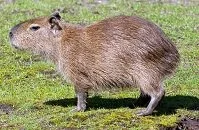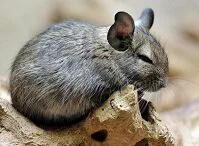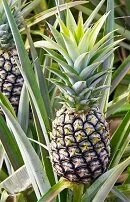Wildlife

Capybara
The wildlife of Uruguay is limited due to the country's landscape, which primarily consists of large grasslands. As few forests exist in the country, the bird and mammal species are smaller in numbers than in some of Uruguay's neighboring countries. Despite this, many of these animals still roam into Uruguay from time to time, although they are rare.
Among the mammals, many can be found but are uncommon, such as opossums, deer, boars, and jaguars. More common are rats, mice, squirrels, and other rodents, including the capybaras, coypu, and the chinchilla.
The sea life is much more varied since the country has a significant amount of coastline along the South Atlantic Ocean. These waters have the most impressive of Uruguay's mammal species with sea lions, whales, and dolphins. The number of fish and shell fish are much larger though. Sharks, grouper, barracuda, eels, shrimp, and many others all call these waters home. Uruguay is also home to many freshwater fish as trout, salmon, pike, catfish, and others live in the country's lakes and rivers.

Chinchilla
These waters also attract many birds that feed off the sea animals. Egrets, eagles, pelicans, condors, pelicans, ducks, swans, and herons are all common along the coast. The inland birds are again somewhat limited because of the lack of forests. Where forests do exist there are additional birds in the country, including parakeets, partridges, quails, crows, and owls.
The reptilian, amphibian, and insect life in Uruguay is diverse, but the lack of forests and a great amount of space does limit the number of species. Many of these animals are spiders, including the tarantula and black widow, and snakes, including the viper. In or near some of the warmer water rivers and lakes the amphibian population spikes a bit as a number of turtles, frogs, and lizards are present. The number of insects is quite substantial, including flies, mosquitos, beetles, moths, butterflies, ants, and more.

Pineapple
When it comes to native plant life, South America is home to many famous edible plants and these plants quickly spread throughout Uruguay, South America, and beyond. The pineapple is from the region where Brazil and Uruguay meet while potatoes and tobacco originated in the Andes Mountains. A few others, including cacao trees (used to make chocolate), peanuts, and tomatoes are also from South America, although their actual origin is unknown. Peppers, both sweet and hot peppers are from Central America or northern South America while vanilla, avocado, papaya, and corn (maize) are likely from Central America itself. No matter each food's origin, what is known is that these foods spread throughout the continent and to the country of Uruguay with the help of pre-historic people, animals, and winds. These people have had these foods for nearly as long as people have inhabited the region and each makes an important part of the people's diet and culture now and for thousands of years into the past.
More than just the edible plants, Uruguay is home to many other trees and plants. Pine trees, eucalyptus trees, carob trees, cedar trees, quebracho tree, algarroba trees, poplar trees, willow trees, palm trees, myrtle trees, rosemary trees, and cypress trees are all common.